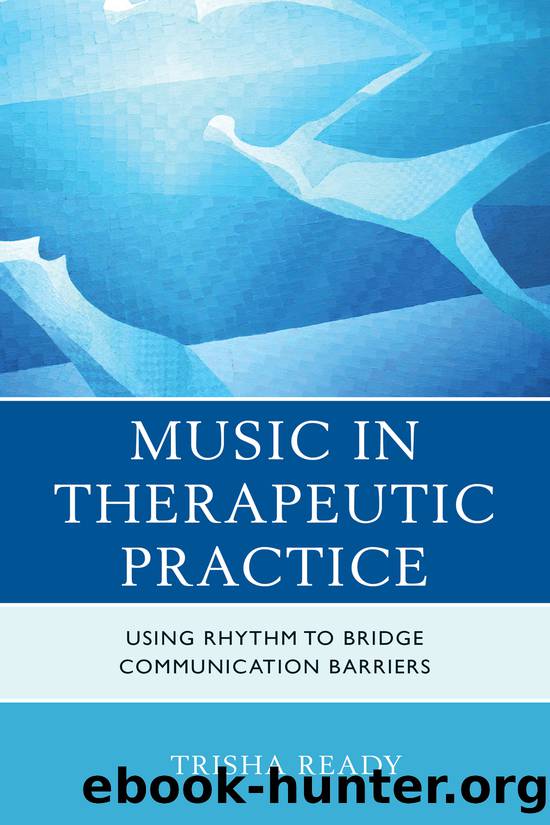Music in Therapeutic Practice by Ready Trisha;

Author:Ready, Trisha;
Language: eng
Format: epub
Publisher: Rowman & Littlefield Unlimited Model
Chapter 7
Wrote on Your Wall Before Leaving
I never listened to music with Alyssa; I never met her. She rented a studio a few doors down from a journalist friend. Before the night Alyssa fell from her window ledge, she had posted several entries on Facebook about childhood sexual abuse. She wrote, âThanks everyone for your concern. I had a rather emotional breakthrough regarding molesting that happened in my past. Iâve dealt with it and you should hope to see really great things from meâ (Frizzelle, 2012). A few days later, she posted: âIâm dealing with things. Maybe we could start a chat group for people who have been through this experience.â This was followed by an entry in which she offered to give coping tools to other molestation survivors. She suggested people message her privately or post on the comment section of her page (Frizzelle, 2012).
This chapter is a fantasy and a case study about potential uses of music to build rapport and establish human connectionâwith people on the brink of suicide. It is possible that music as gesture and tool could help a person in crisis contain overwhelming feelings and metabolize trauma. Music, beginning with an authentic, empathic voice might help a person tolerate intense affective states, including emptiness, until the threat of self-harm has passed. I am also asking us to ponder the importance of making a cultural shift toward mental health recoveryâwherein we consider the perspective of a person experiencing psychosis (which may have been born out of trauma) and how we could engage, include, and listen to her within our communities (Davidson, Tondora, Lawless, OâConnell, & Rowe, 2009).
Emergency rooms and psychiatric hospitals have become central portals where re-enacted traumas are received (Owens et al., 2010; Szegedy-Maszak, 2004). As this trend increases, we will need to discover what hospital best practices might calm rather than re-stimulate trauma for vulnerable patients. At the same time, we could bolster health professionals who may become vicariously traumatized while providing triage treatments for patients in disorganized states. In the midst of layers of chaos, how do professionals hold steady in transitional spaces? In high-stress environments like acute psychiatric hospitals, safe rapport may need to be built within the brief span of one song, or in the gesture of one pink geranium or one calming voice. We clinicians sometimes bear witness to a terrible internal dissonance of abandonment.
We uncover Senecaâs clues left where language has been undone, or decode Annaâs gestural narratives of abuse. Alyssa, who inspired this chapter, re-enacted an earlier traumatic scene through a suicidal gestureâwhat Ferenczi (1929) called âan aversion to life acquired at a young age,â or âthe confusion of being a sexual being before a sexual ageâ (p. 127).
Alyssa had recently relocated from Alaska. The journalist who lived a few doors down encountered her for the first time when he heard screams coming from her apartment late one night. He found other neighbors gathered in the hallway outside Alyssaâs door. Earlier, when two neighbors had knocked, Alyssa,
Download
This site does not store any files on its server. We only index and link to content provided by other sites. Please contact the content providers to delete copyright contents if any and email us, we'll remove relevant links or contents immediately.
Unwinding Anxiety by Judson Brewer(72007)
The Art of Coaching by Elena Aguilar(52202)
The Fast Metabolism Diet Cookbook by Haylie Pomroy(20922)
Rewire Your Anxious Brain by Catherine M. Pittman(18319)
Healthy Aging For Dummies by Brent Agin & Sharon Perkins RN(16928)
Talking to Strangers by Malcolm Gladwell(12887)
The Art of Thinking Clearly by Rolf Dobelli(9929)
Crazy Rich Asians by Kevin Kwan(8894)
Mindhunter: Inside the FBI's Elite Serial Crime Unit by John E. Douglas & Mark Olshaker(8708)
The Compound Effect by Darren Hardy(8523)
Periodization Training for Sports by Tudor Bompa(7929)
Becoming Supernatural by Dr. Joe Dispenza(7844)
Tools of Titans by Timothy Ferriss(7823)
Wonder by R. J. Palacio(7747)
Crystal Healing for Women by Mariah K. Lyons(7715)
Bodyweight Strength Training by Jay Cardiello(7680)
Therapeutic Modalities for Musculoskeletal Injuries, 4E by Craig R. Denegar & Ethan Saliba & Susan Saliba(7601)
Should I Stay or Should I Go? by Ramani Durvasula(7435)
Change Your Questions, Change Your Life by Marilee Adams(7384)
